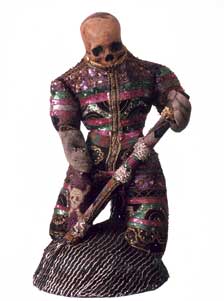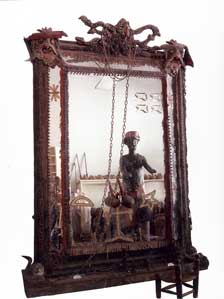> Voodoo
> Broken Memories
Voodoo – Art and Cult from Haiti
The Lehmann Collection must be saved!


Gardé Zazi Wangòl
Miroir d'interpellations
1. Voodoo on Haiti, 2. The history and origins of the Collection, 3. The Marianne Lehmann Collection, 4. Cataloguing the Collection, 5. Exhibitions in Geneva, Amsterdam and Berlin, 6. The museum on Haiti, 7. Timetable
VOODOO ON HAITI
Like Candomblé in Brazil, Santería on Cuba and the Shango cult on Trinidad, Haitian Voodoo is an Afro-American religion founded by blacks brought by force from Africa. These religions are based on the African heritage of their founders in combination with the prevailing socio-historical conditions of the former colonies.
In Haiti, the cult traditions kept alive by slaves from different parts of Africa mingled with the religious concepts of the indigenous Native Americans and elements of the Catholic faith spread throughout the island by the Conquistadors from Spain and later by the French colonial rulers.
Voodoo played an important part in the slaves’ revolt of 1804, the first successful rebellion against the colonisers. Highly original cult objects were developed within their secret societies, which then played an important part in their religious ceremonies. These cult objects are remarkably vibrant, and in many cases are of a very high artistic standard. A synthesis of cult and art.
The Collection’s History of Origins
The Swiss-born Marianne Lehmann has lived in Port-au-Prince on Haiti for almost 50 years. Together with her Haitian husband, she brought up 4 children and worked in the Swiss embassy. Some 25 years ago a Voodoo priest offered to sell her a cult object.
This marked the start of her passion for this important aspect of Haitian culture. Over the years, her knowledge and understanding of these objects has grown. At the same time, Haitian Voodoo priests discovered in Marianne Lehmann a «protector» for their cult objects, which they were mostly obliged to sell for economic reasons.
For them it was clear that Mrs Lehmann would not sell these art treasures to private collectors or museums in Europe and America, and that as a consequence Haiti would not be robbed of its genuine cultural heritage.
up
The Marianne Lehmann Collection
The Collection which Marianne Lehmann has built up over the past 25 years is utterly unique, and represents an extremely valuable contribution to the preservation of this fantastic Haitian cultural heritage. The Collection consists of over 2500 objects, many of which date from the 19th century, and most of which are in excellent condition.
The Collection comprises two main groups of objects. The first is made up of eight large installations – in fact ritual chambers – and a number of further groups of objects which were always intended to form ensembles. What makes these ensembles so unusual is the fact that they have retained their original coherence and offer a wealth of information about the universe from which they derive.
The second group includes thousands of different objects which have been preserved from destruction: jugs, flags, collars, rattles, costumes, statues. While these are displayed individually, they all belong to Voodoo’s ritual arsenal, as the Collection as a whole extensively illustrates.
These exhibits can be divided into three categories:
Objects which belong to the so-called «Ginen Franc» Voodoo tradition, mainly comprising day-to-day, homely customs and traditional religion.
Objects which belong to the magical-religious «Makaya System», which developed out of the martial traditions of the Haitian people. Iconographical representations play an essential role in this rite, which has its roots in the realm of the saints of magic. These were originally created for transformation purposes were integrated in the rites. The Lehmann Collection showcases a whole series of works in this category, whose evocative power is capable of triggering both admiration and bewilderment.
Objects with other origins: the Collection also encompasses a number of objects which do not have a ritualistic purpose. These were created above all from an aesthetic perspective. Even if the artistic motivation behind their creation was fed by inspiration rooted in the sphere of the holy (the artists were mostly Voodoo priests, or at least individuals who had been initiated), these works were designed primarily for decorative and ornamental purposes.
The Collection is housed in a building made available by Mrs Lehmann and which has been fitted with extensive shelving. The visitor is led through the entire 7-room building, filled from top to bottom with exhibits.
The adjacent rear courtyard contains above all man-sized ceramic figures which are only cursorily protected by a wooden roof.
Mrs Lehmann built up this Collection with tremendous commitment, not to mention a great many personal sacrifices which should not be underestimated. The co-operation with her has always been excellent, and also promises remain so in the future.
up
Cataloguing the Collection
Mrs Lehmann and the «Fondation pour la Preservation, la Valorisation et la Production d’Oeuvres Culturelles Haïtiennes» which supports her are delighted that it will be possible to continue cataloguing the Collection now that NAWAO has been able to organise the necessary money from the DEZA and the Gartenflügel Foundation.
To date, approx. 500 objects have already been recorded. This work is being done in co-operation with Marianne Lehmann, Hénock Trouillot, Reynal Trouillot and Rachel Beauvoir, all of whom are «Foundation» members, and who have extensive specialist expertise. This work is being performed with the support of students of the University of Port-au-Prince.
The objects are being recorded in an extremely professional manner, including by electronic means. The money should be sufficient to catalogue the very most important exhibits, as well as to undertake pest control activities and to restore individual objects.
up
Exhibitions in Europe
The exploratory trip to Haiti has confirmed that the extensive «Lehmann Collection» can be used to create an outstanding, exciting – indeed spectacular and unique exhibition for Europe.
The work of a variety of highly-qualified Haitian experts in the field of Voodoo will be extremely valuable when it comes to communicating these exhibits. The academics and researchers will also be available during the development of the exhibition concept, as well as with respect to the drawing up of the catalogue.
Initial assessments have shown that there is undeniably considerable interest within Europe in an exhibition of this, the world’s largest collection of Voodoo cult objects from Haiti.
To date, three museums have signalled their willingness to take part: the Musée d'Ethnographie de la ville de Genève, the Tropenmuseum in Amsterdam and the Ethnologische Museum Berlin-Dahlem. The director of the museum in Geneva, Jacques Hainard, will oversee the selection of the objects for the exhibitions in Europe, working in conjunction with the local curators Rachel Beauvoir and Marianne Lehmann.
The museums are due to hold a meeting in March 2006, at which they will decide how they plan to proceed with this project. The next evaluation with the curators on Haiti is scheduled for April 2006.
The exhibition will be developed in close co-operation with the four museums. Various aspects of Haitian culture will be drawn upon for this, whereby the Lehmann Collection will form the principal focus of the exhibition. In conjunction with these exhibitions, there is also a plan to jointly realise the museum project in Port-au-Prince which is needed to preserve the Lehmann Collection. In concrete terms, this means we will only be working with institutions which are also willing to commit themselves in the long-term to the museum project, within the framework of their capabilities.
The transport of the works to Europe in containers will require extensive packaging know-how, as many of the objects are extremely fragile. Customs formalities can be settled via a partner company of Panalpina Schweiz.
In short, it is possible to state that it should be relatively straightforward to realise the exhibition concept, along with the necessary local know-how and the transport and export of the works. The NAWAO production structure, with offices in Berlin, Paris and Zurich, means we will be able to co-ordinate and organise the exhibition in these countries, in addition to pursuing the campaign for the new museum on Haiti.
up
The museum on Haiti
Political feasibility
It is clear that at the present time, that is to say in Haiti’s current unstable environment, it will not be possible to realise a museum. However, it should be possible to realise this project once the situation becomes more stable. What are required are an effective and sustainable concept and strong institutional backing. The new museum could be opened in 2010.
In addition to exhibition spaces for the «Lehmann Collection» and storage facilities, the current vision of a “Foundation” for a museum also includes rooms for changing contemporary exhibitions, facilities for the restoration of the objects, a small specialist library, a restaurant and a museum shop
The necessary institutional backing
Institutional backing could be in the form of the “Foundation” which has excellent qualifications and which has overseen the “Lehmann Collection” with commitment and dedication for the past 15 years. Also involved is Rachel Beauvoir, the ethnologist and outstanding Voodoo expert. She has already published a great deal on the subject, and would be ideal as the local curator for the exhibitions in Europe.
The Foundation currently consists of five persons. Were this Foundation to be reinforced by distinguished individuals with corresponding specialist expertise, then this could certainly develop into an effective, long-term corporate body to oversee the Museum.
up
Finance
In Port-au-Prince I had the opportunity of meeting representatives from a wide variety of GOs and NGOs, and presented the plan to establish a museum in Haiti. The two EU representatives, Henri Got and Rune Skinnebach, were particularly interested in the aspect of preserving Haiti’s cultural heritage.
In the view of these two individuals, it may be possible to secure substantial funding for the museum from the EU.
During the course of many discussions I also presented various aspects of this project inter alia to Michèle Pierre-Louis, the Director of FOKAL (Soros), to the Canadian Ambassador Claude Boucher, who also visited the Collection, Gaël Monnin of the Monnin Gallery, Garaudy Laguerre, Director of the Norwegian NGO ISPOS, Elise Benoit, Deputy Director of the United Nations WFP, Pierre Esperance, Director of the Haitian human rights organisation «Reseau National de Défense des Droits Humains», Ute Braun, Regional Director of the Deutsche Welthungerhilfe (German Agro Action), Hans-Christoph Buch, author with Haitian roots, Markus Probst of the Swiss Consulate and Bernhard Zaugg from Helvetas. The impression I gathered during these discussions was that, in general terms, the preservation of Haiti’s particular cultural heritage was very much welcomed. The discussions focussed primarily on practical and financial aspects, while certain organisations raised the prospect of their providing the project with a wide variety of support.
The next evaluation trip will provide an opportunity to finalise further details of the museum concept, to draw up budgets, and above all to evaluate the museum’s necessary support structures in greater depth.
Timetable
March 2006: Meeting of the four museums from Geneva, Amsterdam, Berlin and Paris
April 2006: Further evaluation tour with the curator Jacques Hainard
Sept. 07 – March 2008: Exhibition at the Musée d'Ethnographie de la ville de Genève, Switzerland
Sept. 08 – Febr. 2009: Tropen Museum Amsterdam, Netherlands
Mai 09 – Sept. 2009: Ethnologisches Museum Berlin-Dahlem, Germany
Dec. 09 – Mai 2010: 3. Museum in EU
2006 - 2010: Setting up the necessary structures for the museum on Haiti, as well as securing the funding, establishing the museum
2010: Opening the Museum of Voodoo Cult Objects on Haiti
up